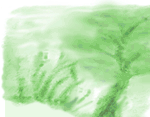



|
|
The following information has been taken from the Leeds City Council web site as well as that of the Environment Agency. It is included because Japanese Knotweed is already present in Gledhow Valley Woods, and is beginning to spread!
What is Japanese Knotweed?
Japanese Knotweed was introduced to the UK as an ornamental plant during the 1800s. It is commonly found today along railway lines, riverbanks, roads and footpaths, in graveyards, on derelict sites or anywhere that it has been dumped, dropped or deposited. It is already present in Gledhow Valley Woods!
What does it look like?
Japanese Knotweed forms dense clumps up to three metres in height. It has large, oval green leaves and a stem that is hollow and similar to bamboo (a photo can be seen in the Plants of Gledhow Valley section). Usually in early spring (although it can be later in the year) the plant produces fleshy red tinged shoots. These can reach a height of 1.5 metres by May and three metres by June.
This plant can grow as much as 2 cms per day and will grow in any type of soil, no matter how poor. Towards the end of August clusters of cream flowers develop and then produce seeds that are sterile. The plant dies back between September and November.
Beneath any stand of Japanese Knotweed will exist an extensive underground root (rhizome) network that can extend several metres around and beneath depending on ground conditions. The spread of the plant is vegetative, i.e. all new plants are created by fragments of existing plants. A fragment of root as small as 0.8 grams can grow to form a new plant.
Why is it a problem?
Japanese Knotweed grows pretty much anywhere, from field edges to sand dunes, through asphalt and out of lamp-posts. The speed with which it has spread to all parts of the UK has been spectacular when you consider that it does not leave seeds behind but grows from pieces of the plant or root system that are cut and transported by people or by water.
Because Japanese Knotweed does not originate in the UK, its does not compete fairly with our native species and is able to spread unchecked. Once established, Japanese Knotweed shades out native plants by producing a dense canopy of leaves early in the growing season. Although Japanese Knotweed is not toxic to humans, animals or other plants, it offers a poor habitat for native insects, birds and mammals.
Under the Wildlife and Countryside Act 1981, causing the plant to spread is an offence.
What to do if you find Japanese Knotweed?
The plant is extremely difficult to get rid of - attempts to control the weed often fail and re-growth occurs. It is very important not to do anything that may help the knotweed to spread. In particular transporting any part of the plant to another site may produce other infestations and may leave you liable to prosecution. The plant can grow through tarmac roads, between joints and cracks in concrete slabs, within cavity walls and drains.
Do not:
You should:
If you find it on your property it should be treated on site to minimise the risk of spreading. For further information please contact the Environment Agency.
|
|
 |